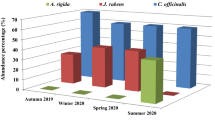Abstract
Three forms of the carrageenan-containing red alga Tichocarpus crinitus (Gmel.) Rupr. have been found in Sivuch'ya Bay, Sea of Japan. The paper provides descriptions of morphological, anatomical, and some physiological features of the forms and environmental conditions in their habitats. It is shown that different forms appear under the effects of ecological factors and the adaptation to different environmental conditions is revealed via morphological, anatomical, and some physiological changes in the algae. It is supposed that the polymorphism in T. crinitus ensures morphological and functional adaptation of an organism to its environmental conditions.
Similar content being viewed by others
REFERENCES
Ermak, I.M. and Khotimchenko, Yu.S., Physico-Chemical Properties, Applications, and Biological Activities of Carrageenan—A Polysaccharide of Red Algae, Biol. Morya, 1997, vol. 23, no. 3, pp. 129-142.
Koz'menko, V.B., Titlyanov, E.A., and Makarycheva, A.M., Growth of Unattached Form of Gracilaria verrucosa in Lagoons of Southern Primorye, Biol. Morya, 1994, vol. 20, no. 1, pp. 42-48.
Moshchenko, A.V., Vanin, N.S., and Lamykina, A.E., Bottom Relief, Bottom Sediments, and Hydrological Conditions in the Russian Part of Mouth Area of the Tumannaya River, Ekologicheskoe sostoyanie i biota yugo-zapadnoi chasti zaliva Petra Velikogo i ust'ya reki Tumannoi (Ecological Condition and Biota of South-western Peter the Great Bay and the Mouth Area of the Tumannaya River), Vladivostok: Dal'nauka, 2000, vol. 1, pp. 42-75.
Perestenko, L.P., Krasnye vodorosli dal'nevostochnykh morei Rossii (Red Algae of Far-Eastern Seas of Russia), St.-Petersburg: Nauka, 1994.
Romanyuk, V.A. and Oskol'skaya, O.I., Effects of Different Concentrations of Ammonium in the Environment of Growth and Thallus Development of Gracilaria verrucosa and Gracilaria Species, Ekol. Morya, 1991, issue 37, pp. 49-56.
Skriptsova, A.V., Popova, L.I., and Titlyanova, T.V., Polymorphism of Unattached Red Alga Gracilaria verrucosa in the Lagoons of Primorye, Biol. Morya, 1998, vol. 24, no. 6, pp. 377-382.
Titlyanov, E.A., Glebova, N.T., and Kotlyarova, L.S., Seasonal Changes in the Structure of Thalluses of Ulva fenestrata P. et R., Biol. Morya, 1975, no. 4, pp. 36-41.
Khristoforova, N.K., Osnovy ekologii (Fundamentals of Ecology), Zhirmunskii, A.V., Ed., Vladivostok: Dal'nauka, 1999.
Chen, L.C.-M. and Taylor, A.R.A., Investigation of Distinct Strains of Chondrus crispus Stackh. II. Culture Studies, Bot. Mar., 1980, vol. 23, pp. 441-448.
Chopin, T. and Floc'h, J., Eco-physiological and Bio-chemical Study of Two of the Most Contrasting Forms of Chondrus crispus (Rhodophyta, Gigartinales), Mar. Ecol. Progr. Ser., 1992, vol. 81, pp. 185-195.
Dixon, P.S., On the Form of the Thallus in the Florideo-phyceae. Trends in Plant Morphogenesis, London, 1963.
Gutierrez, L.M. and Fernandez, C., Water Motion and Morphology in Chondrus crispus (Rhodophyta), J. Phycol., 1992, vol. 28, pp. 156-162.
Hanisak, M.D., Littler, M.M., and Littler, D.S., Significance of Macroalgal Polymorphism: Intraspecific Test of the Functional-Form Model, Mar. Biol. (Berl.), 1988, vol. 99, pp. 157-165.
Jackelman, J.J. and Bolton, J.J., Form Variation and Productivity of an Intertidal Foliose Gigartina Species (Rhodophyta) in Relation to Wave Exposure, Hydrobiologia, 1990, vols. 204/205, pp. 57-60.
Laing, W.A., Christeller, J.T., and Tezzaghy, B.E., The Effect of Temperature Photon Flux Density and Nitrogen on Growth of Gracilaria sordida Nelson (Rhodophyta), Bot. Mar., 1989, vol. 32, pp. 439-445.
Lignell, A. and Pedersen, M., Agar Composition as a Function of Morphology and Growth Rate. Studies on Some Morphological Strains of Gracilaria secundata and Gracilaria verrucosa (Rhodophyta), Bot. Mar., 1989, vol. 32, pp. 219-227.
Mairh, O.P., Ramavat, B.K., and Sreenivasa, Rao P., Nutrition, Growth and Tetraspore Induction of Gelidiella acerosa (Forssk.) Feld. et Hamel (Gelididaceae, Rhodophyta) in Culture, Bot. Mar., 1990, vol. 33, no. 2, pp. 133-141.
Peterson, R.D., Effects of Light Intensity on the Morphology and Productivity of Caulerpa racemosa (Forskal) J. Agardh, Micronesica, 1972, vol. 8, pp. 63-86.
Wainwright, A.S., Biggs, W.D., Curry, J.D., and Gosline, J.M., Mechanical Design in Organisms, New York: J. Wiley and Sons, 1976.
Yakovleva, I.M., Yermak, I.M., Titlyanov, E.A., et al., Changes in Growth Rate, Anatomy and Polysaccharide Content of a Sterile Form of Tichocarpus crinitus (Gmel.) Rupr. (Rhodophyta, Tichocarpaceae) under Differing Photon Irradiances in the Sea of Japan (Russia), Bot. Mar., 2001, vol. 44, no. 5, pp. 493-500.
Yermak, I.M., Yong Hwan Kim, Titlyanov, E.A., et al., Chemical Structure and Gel Properties of Carrageenans From Algae Belonging to the Gigartinaceae and Tichocarpaceae Collected from the Russian Pacific Coast, J. Appl. Phycol., 1999, vol. 11, pp. 41-48.
Author information
Authors and Affiliations
Rights and permissions
About this article
Cite this article
Yakovleva, I.M., Skriptsova, A.V. II. Polymorphism of the Carrageenan-Containing Red Alga Tichocarpus crinitus in Sivuch'ya Bay, Sea of Japan. Russian Journal of Marine Biology 28, 65–69 (2002). https://doi.org/10.1023/A:1014489816749
Issue Date:
DOI: https://doi.org/10.1023/A:1014489816749




